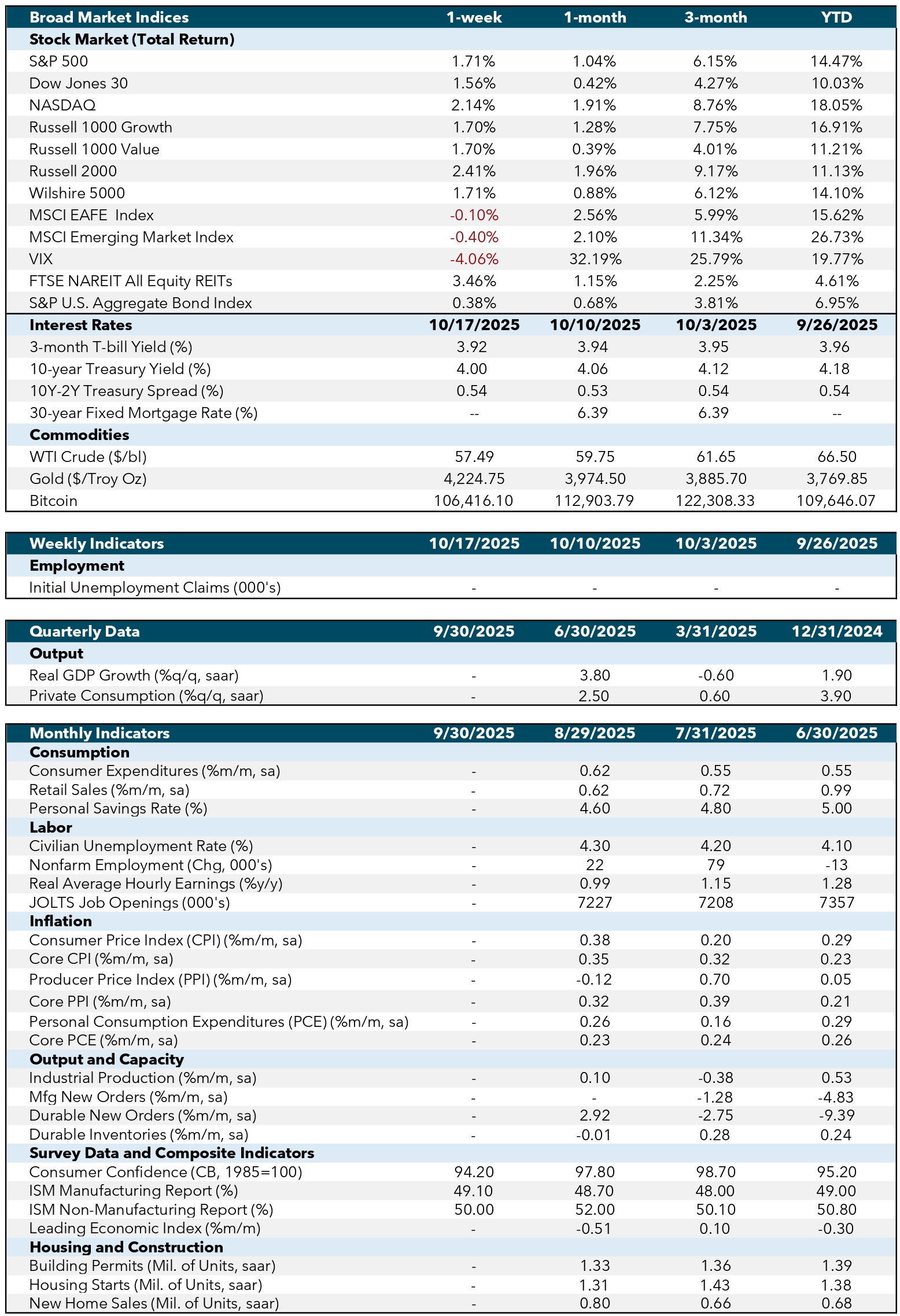Weekly Market Commentary
October 20th, 2025
Week in Review…
Economic developments during the week were shaped by key inflation data, central bank commentary, and disruptions caused by the ongoing government shutdown. Together, these events offered insight into the Federal Reserve’s evolving stance and the challenges of navigating a data-constrained environment.
On Tuesday, October 14, Fed Chair Jerome Powell addressed the National Association for Business Economics, warning of “significant downside risks” in the labor market and signaling that the Fed may soon end its balance sheet runoff. Powell emphasized the difficulty of operating without full government data, noting reliance on private labor indicators and that substitutes for official inflation data are “less good.” His remarks reinforced expectations for a more cautious and dovish policy approach.
On Wednesday, the Consumer Price Index (CPI) for September showed a 0.4% month-over-month increase, while Core CPI rose 0.3%, bringing the year-over-year Core CPI to 3.7%. These figures suggest inflation remains persistent but is not accelerating, supporting the view that price pressures are stabilizing.
Thursday’s Producer Price Index (PPI) added complexity to the inflation picture. Headline PPI rose 0.5%, and Core PPI increased 0.3%, reversing the prior month’s decline. The data hinted at renewed wholesale cost pressures, which could eventually filter into consumer prices.
Meanwhile, the government shut down delayed several key reports, including retail sales and the full employment summary. Bloomberg and other sources reported that CPI data collection was strained, and policymakers are increasingly “flying blind” without timely indicators. The shutdown has created a data vacuum, complicating the Fed’s ability to assess economic conditions accurately.
Overall, the week highlighted the Fed’s balancing act: stabilizing inflation, monitoring labor risks, and adjusting policy amid limited visibility. Powell’s tone and the inflation data suggest a shift toward caution as uncertainty grows.
Week Ahead…

With the government shutdown still in effect, markets continue to operate in a data-constrained environment. The September jobs report remains delayed, and other key releases, including weekly jobless claims and the retail sales report, are also postponed. Even the Consumer Price Index, originally scheduled for October 15, has been pushed to October 24 to support Social Security Cost-of-Living Adjustment (COLA) calculations.
In the absence of fresh government data, investors will increasingly rely on private-sector releases and Fed communications. This week features a heavy slate of speeches from Federal Reserve officials, including Vice Chair Bowman and Governor Barr. With Chair Powell’s expected departure in 2026, markets may begin shifting their attention toward the broader committee for clues on the future policy path, especially as consensus-building becomes more critical in a fragmented data environment.
Additionally, global energy reports may offer indirect insights into economic momentum. The OPEC Monthly Oil Market Report (October 13) and the IEA Monthly Oil Market Report (October 14) will provide detailed views on oil supply, demand, and pricing trends. These reports, unaffected by the shutdown, may help markets assess inflationary pressures and industrial activity through the lens of energy consumption and production.
In this environment, every speech, survey, and tangential indicator may begin to take on outsized importance as markets prepare for the Fed’s October 28–29 meeting.
Economic Indicators:
- CPI: Consumer Price Index measures the average change in prices paid by consumers for goods and services over time. Source: Bureau of Labor Statistics.
- Core CPI: Core Consumer Price Index excludes food and energy prices to provide a clearer picture of long-term inflation trends. Source: Bureau of Labor Statistics.
- PPI: Producer Price Index measures the average change in selling prices received by domestic producers for their output. Source: Bureau of Labor Statistics.
- Core PPI: Core Producer Price Index excludes food and energy prices to provide a clearer picture of long-term inflation trends. Source: Bureau of Labor Statistics.
- PCE: Personal Consumption Expenditures measure the average change in prices paid by consumers for goods and services. Source: Bureau of Economic Analysis.
- Core PCE: Core Personal Consumption Expenditures exclude food and energy prices to provide a clearer picture of long-term inflation trends. Source: Bureau of Economic Analysis.
- Industrial Production: Measures the output of the industrial sector, including manufacturing, mining, and utilities. Source: Federal Reserve.
- Mfg New Orders: Measures the value of new orders placed with manufacturers for durable and non-durable goods. Source: Census Bureau.
- Durable New Orders: Measures the value of new orders placed with manufacturers of durable goods. Source: Census Bureau.
- Durable Inventories: Measures the value of inventories held by manufacturers for durable goods. Source: Census Bureau.
- Consumer Confidence (CB, 1985=100): Measures the degree of optimism that consumers feel about the overall state of the economy and their personal financial situation. Source: Conference Board.
- ISM Manufacturing Report: Measures the economic health of the manufacturing sector based on surveys of purchasing managers. Source: Institute for Supply Management.
- ISM Non-Manufacturing Report: Measures the economic health of the non-manufacturing sector based on surveys of purchasing managers. Source: Institute for Supply Management.
- Leading Economic Index: Measures overall economic activity and predicts future economic trends. Source: Conference Board.
- Building Permits (Mil. of Units, saar): Measures the number of new residential building permits issued. Source: Census Bureau.
- Housing Starts (Mil. of Units, saar): Measures the number of new residential construction projects that have begun. Source: Census Bureau.
- New Home Sales (Mil. of Units, saar): Measures the number of newly constructed homes sold. Source: Census Bureau.
- SA: Seasonally adjusted.
- SAAR: Seasonally adjusted annual rate.
Market Indices & Indicators:
- S&P 500: A market-capitalization-weighted index of 500 leading publicly traded companies in the U.S., widely regarded as one of the best gauges of large U.S. stocks and the stock market overall.
- Dow Jones 30: Also known as the Dow Jones Industrial Average, it tracks the share price performance of 30 large, publicly traded U.S. companies, serving as a barometer of the stock market and economy.
- NASDAQ: The world’s first electronic stock exchange, primarily listing technology giants and operating 29 markets globally.
- Russell 1000 Growth: Measures the performance of large-cap growth segment of the U.S. equity universe, including companies with higher price-to-book ratios and growth metrics.
- Russell 1000 Value: Measures the performance of large-cap value segment of the U.S. equity universe, including companies with lower price-to-book ratios and growth metrics.
- Russell 2000: A market index composed of 2,000 small-cap companies, widely used as a benchmark for small-cap mutual funds.
- Wilshire 5000: A market-capitalization-weighted index capturing the performance of all American stocks actively traded in the U.S., representing the broadest measure of the U.S. stock market.
- MSCI EAFE Index: An equity index capturing large and mid-cap representation across developed markets countries around the world, excluding the U.S. and Canada.
- MSCI Emerging Market Index: Captures large and mid-cap representation across emerging markets countries, covering approximately 85% of the free float-adjusted market capitalization in each country.
- VIX: The CBOE Volatility Index measures the market’s expectations for volatility over the coming 30 days, often referred to as the “fear gauge.”
- FTSE NAREIT All Equity REITs: Measures the performance of all publicly traded equity real estate investment trusts (REITs) listed in the U.S., excluding mortgage REITs.
- S&P U.S. Aggregate Bond Index: Represents the performance of the U.S. investment-grade bond market, including government, corporate, mortgage-backed, and asset-backed securities.
- 3-Month T-bill Yield (%): The yield on U.S. Treasury bills with a maturity of three months, reflecting short-term interest rates.
- 10-Year Treasury Yield (%): The yield on U.S. Treasury bonds with a maturity of ten years, reflecting long-term interest rates.
- 10Y-2Y Treasury Spread (%): The difference between the yields on 10-year and 2-year U.S. Treasury bonds, often used as an indicator of economic expectations.
- WTI Crude ($/bl): The price per barrel of West Texas Intermediate crude oil, a benchmark for U.S. oil prices.
- Gold ($/Troy Oz): The price per troy ounce of gold, a standard measure for gold prices.
- Bitcoin: A decentralized digital currency without a central bank or single administrator, which can be sent from user to user on the peer-to-peer bitcoin network.
This content was developed by Cambridge from sources believed to be reliable. This content is provided for informational purposes only and should not be construed or acted upon as individualized investment advice. It should not be considered a recommendation or solicitation. Information is subject to change. Any forward-looking statements are based on assumptions, may not materialize, and are subject to revision without notice. The information in this material is not intended as tax or legal advice.
Investing involves risk. Depending on the different types of investments there may be varying degrees of risk. Socially responsible investing does not guarantee any amount of success. Clients and prospective clients should be prepared to bear investment loss including loss of original principal. Indices mentioned are unmanaged and cannot be invested into directly. Past performance is not a guarantee of future results.
The Dow Jones Industrial Average (DJIA) is a price-weighted index composed of 30 widely traded blue-chip U.S. common stocks. The S&P 500 is a market-cap weighted index composed of the common stocks of 500 leading companies in leading industries of the U.S. economy. The NASDAQ Composite Index is a market-value weighted index of all common stocks listed on the NASDAQ stock exchange.
Securities offered through Cambridge Investment Research, Inc., a broker-dealer, member FINRA/SIPC, and investment advisory services offered through Cambridge Investment Research Advisors, Inc., a Registered Investment Adviser. Both are wholly-owned subsidiaries of Cambridge Investment Group, Inc. V.CIR.1025-3773

